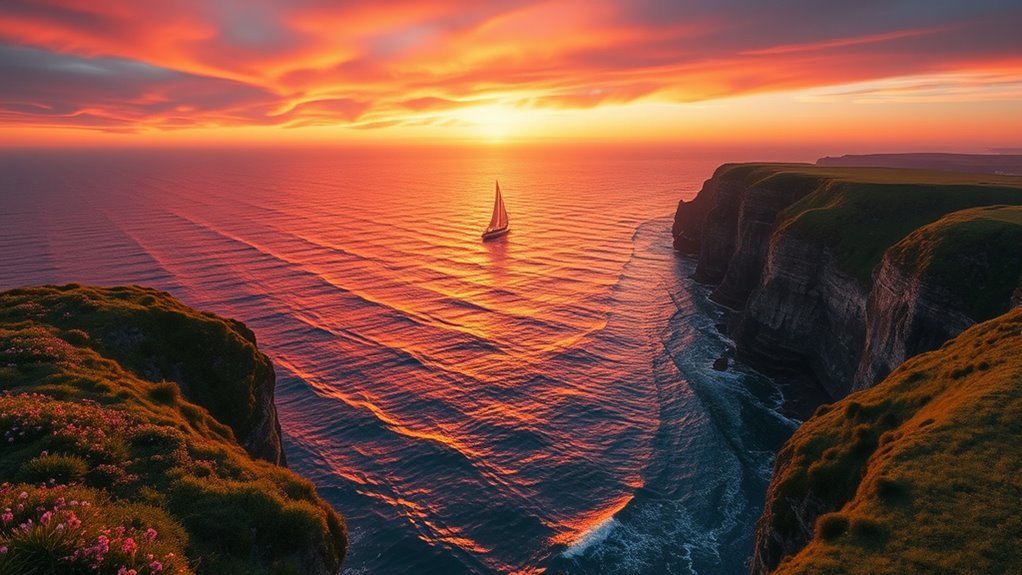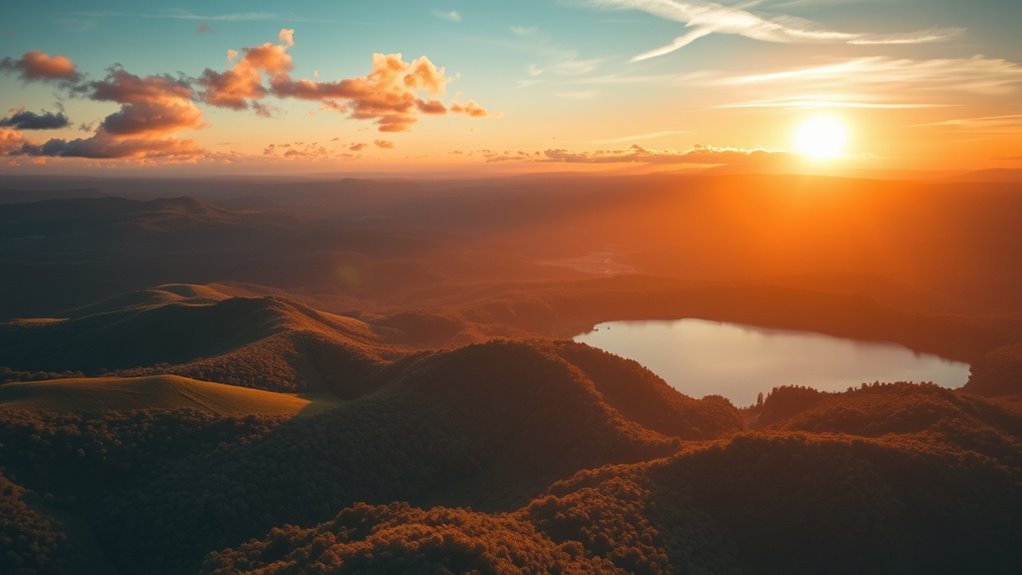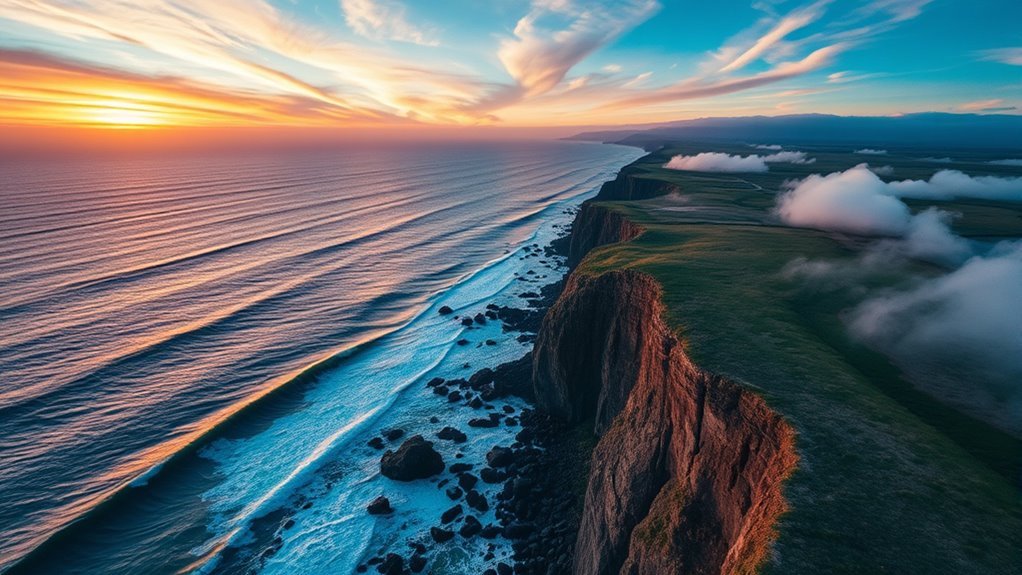To master drone photography, get familiar with your camera settings. Adjust ISO for clearer shots, choose shutter speed based on motion, and use aperture to control light and depth. Employ essential composition techniques like the rule of thirds and leading lines to enhance your photos. Pay attention to lighting conditions, particularly during the golden hour. Experimenting with various angles can yield unique perspectives. Keep exploring to reveal more creative insights and techniques for stunning aerial images.
Understanding Your Drone’s Camera Settings

As you prepare to take flight with your drone, understanding its camera settings is crucial for capturing stunning aerial imagery. Start with ISO settings; lower values reduce noise but require more light, while higher values are best in dim conditions. Next, consider shutter speed—this controls the exposure time. A fast shutter freezes motion, while a slower setting can create striking motion blur, enhancing your shots’ dynamism. Aperture control is equally important; a wider aperture allows more light and creates a shallow depth of field, isolating subjects beautifully. Additionally, the 12MP camera excels in capturing fine detail across varied lighting conditions, ensuring your photographs are sharp and vibrant. Finally, don’t overlook white balance, which guarantees colors remain true to life. Mastering these settings grants you the freedom to express your creativity in the skies, turning ordinary scenes into extraordinary images. Additionally, understanding your drone’s camera quality and features can significantly enhance the overall quality of your photographs.
Essential Composition Techniques for Aerial Photography

While mastering your drone’s camera settings is essential, understanding composition techniques can elevate your aerial photography to new heights. Embrace the rule of thirds to create dynamic images; position key elements along grid lines or at intersections for balance. Experiment with framing techniques, such as using natural elements to draw attention to your subject.
Here’s a quick reference table to inspire your compositions:
| Technique | Description | Example |
|---|---|---|
| Rule of Thirds | Divide the frame into thirds for balance | Position horizon along a line |
| Leading Lines | Use paths or rivers to guide the viewer’s eye | Roads leading to a focal point |
| Framing | Create borders with trees or buildings | Archway framing a landscape |
| Symmetry | Capture balanced elements for harmony | Reflections in water |
| Foreground Interest | Add elements in the foreground for depth | Rocks or flowers in the front |
Mastering Lighting and Weather Conditions

Great composition techniques can only take your aerial photography so far without considering the impact of lighting and weather conditions. The golden hour, just after sunrise or before sunset, offers soft, warm light that can transform your images, enhancing colors and depth. Plan your flights around this magical time to capture breathtaking scenes.
Additionally, be mindful of weather patterns. Overcast skies can diffuse harsh sunlight, creating a moody atmosphere, while dramatic clouds can add depth and interest. However, windy conditions can compromise stability, so check forecasts before taking off. Understanding how different weather influences light will empower you to seize the moment, creating stunning aerial images that resonate with your audience’s desire for freedom and exploration. Remember that drones like the DJI Air 3 offer enhanced obstacle sensing, which can be particularly useful in unpredictable weather conditions. The Freefly Alta 8 boasts an advanced vibration dampening system, ensuring smoother flights in challenging weather, which is crucial for capturing quality images.
Post-Processing Tips to Enhance Your Aerial Images
To truly elevate your aerial images, mastering post-processing techniques is vital, especially since even the most stunning captures can benefit from a little enhancement. Start with color correction to guarantee your images pop; adjust the saturation and contrast to bring life to your landscapes. Don’t shy away from playing with white balance to achieve that perfect tone. Next, implement noise reduction to eliminate any unwanted grain, especially in low-light shots. This step’s important for maintaining clarity in your images. Finally, crop or straighten your photos to enhance composition and draw focus to your subject. With these techniques, you’ll reveal the full potential of your drone photography, allowing your creativity to soar free.
Exploring Creative Perspectives and Angles
After refining your aerial images through post-processing, it’s time to think about how you capture them in the first place. Embrace the freedom that your drone offers and seek out unique viewpoints that tell a story. Move beyond standard shots; experiment with dynamic angles to create depth and intrigue. Try low altitude flights for dramatic perspectives or high altitudes for sweeping landscapes. Don’t hesitate to tilt your camera for an unconventional look—this can transform ordinary scenes into extraordinary compositions. Remember, the best shots often come from unexpected positions, so be bold and adventurous. By pushing the boundaries of traditional photography, you’ll elevate your work, connecting emotionally with viewers through your unique vision. The Cinemaster 2’s exceptional camera quality enhances your ability to capture stunning visuals, making every shot an opportunity for creativity. To maximize your shots, consider the 12-megapixel sensor capabilities that ensure stable and vibrant images.
Frequently Asked Questions
What Are the Legal Restrictions for Flying Drones in My Area?
To guarantee you’re flying safely, check your local laws regarding drone regulations. Each area has specific rules, and staying informed protects your freedom to soar while respecting others’ rights and safety in the airspace.
How Can I Ensure My Drone Is Stable During Flight?
To guarantee your drone’s stable during flight, regularly perform drone calibration and select the appropriate flight mode. This enhances balance and responsiveness, allowing you to navigate the skies with confidence and freedom, capturing stunning aerial perspectives.
What Type of Drone Is Best for Photography Beginners?
Imagine soaring above breathtaking landscapes; for beginners, a drone with excellent camera quality and decent flight time is essential. Look for models like the DJI Mini series, balancing performance and ease, ensuring your creative freedom.
How Do I Choose the Right Lens for Aerial Photography?
Choosing the right lens for aerial photography means considering wide angle benefits for expansive shots and ensuring lens compatibility with your drone. This way, you’ll capture stunning perspectives while enjoying the freedom of creative exploration.
Can I Use My Smartphone to Control the Drone’s Camera?
Yes, you can use your smartphone to control the drone’s camera, provided it’s compatible. Access camera settings through the app, allowing you to adjust parameters and capture stunning aerial shots with ease and creativity.

